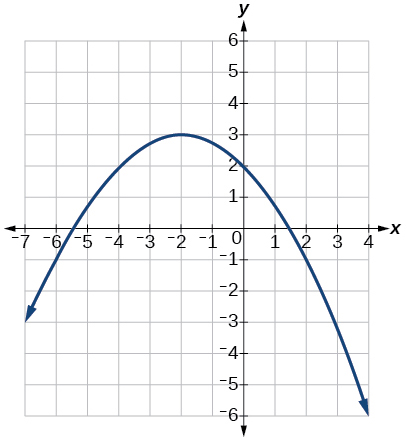Introduction to Quadratic Functions and Parabolas
For the following exercises, rewrite the quadratic functions in standard form and give the vertex.
- [latex]g(x)=x^2+2x−3[/latex]
- [latex]f(x)=x^2+5x−2[/latex]
- [latex]k(x)=3x^2−6x−9[/latex]
- [latex]f(x)=3x^2-5x-1[/latex]
For the following exercises, determine whether there is a minimum or maximum value to each quadratic function. Find the value and the axis of symmetry.
- [latex]f(x)=2x^2−10x+4[/latex]
- [latex]f(x)=4x^2+x−1[/latex]
- [latex]f(x)=\frac{1}{2}x^2+3x+1[/latex]
For the following exercises, determine the domain and range of the quadratic function.
- [latex]f(x)=(x−3)^2+2[/latex]
- [latex]f(x)=x^2+6x+4[/latex]
- [latex]k(x)=3x^2−6x−9[/latex]
For the following exercises, use the vertex [latex](h,k)[/latex] and a point on the graph [latex](x,y)[/latex] to find the general form of the equation of the quadratic function.
- [latex](h,k)=(−2,−1),(x,y)=(−4,3)[/latex]
- [latex](h,k)=(2,3),(x,y)=(5,12)[/latex]
- [latex](h,k)=(3,2),(x,y)=(10,1)[/latex]
- [latex](h,k)=(1,0),(x,y)=(0,1)[/latex]
For the following exercises, sketch a graph of the quadratic function and give the vertex, axis of symmetry, and intercepts.
- [latex]f(x)=x^2−6x−1[/latex]
- [latex]f(x)=x^2−7x+3[/latex]
- [latex]f(x)=4x^2−12x−3[/latex]
For the following exercises, write the equation for the graphed quadratic function.
Complex Numbers and Operations
For the following exercises, plot each number in the complex plane.
- [latex]4[/latex]
- [latex]–3i[/latex]
- [latex]–2+3i[/latex]
- [latex]2 + i[/latex]
- [latex]-2[/latex]
- [latex]4i[/latex]
- [latex]1+2i[/latex]
- [latex]-1-i[/latex]
For the following exercises, solve.
- [latex](2+3i) + (3-4i)[/latex]
- [latex](3-5i) - (-2-i)[/latex]
- [latex](1-i) + (2+4i)[/latex]
- [latex]( -2-3i) - (4-2i)[/latex]
For the following exercises, multiply the expressions.
- latex]3(2+4i)[/latex]
- [latex](2i)(-1-5i)[/latex]
- [latex](2-4i)(1+3i)[/latex]
- [latex]2(-1+3i)[/latex]
- [latex](3i)(2-6i)[/latex]
- [latex](1-i)(2+5i)[/latex]
- Plot the number [latex]2+3i[/latex]. Does multiplying by [latex]1-i[/latex] move the point closer to or further from the origin? Does it rotate the point, and if so which direction?
- Plot the number [latex]2+3i[/latex]. Does multiplying by [latex]0.75+0.5i[/latex] move the point closer to or further from the origin? Does it rotate the point, and if so which direction.
Application of Quadratic Functions
- Suppose that the price per unit in dollars of a cell phone production is modeled by [latex]p=$45-0.0125x[/latex], where [latex]x[/latex] is in thousands of phones produced, and the revenue represented by thousands of dollars is [latex]R=x\cdot p[/latex]. Find the production level that will maximize revenue.
- A ball is thrown in the air from the top of a building. Its height, in meters above ground, as a function of time, in seconds, is given by [latex]h(t)=-4.9t^2+24t+8[/latex]. How long does it take to reach maximum height?
- A farmer finds that if she plants [latex]75[/latex] trees per acre, each tree will yield [latex]20[/latex] bushels of fruit. She estimates that for each additional tree planted per acre, the yield of each tree will decrease by [latex]3[/latex] bushels. How many trees should she plant per acre to maximize her harvest?
